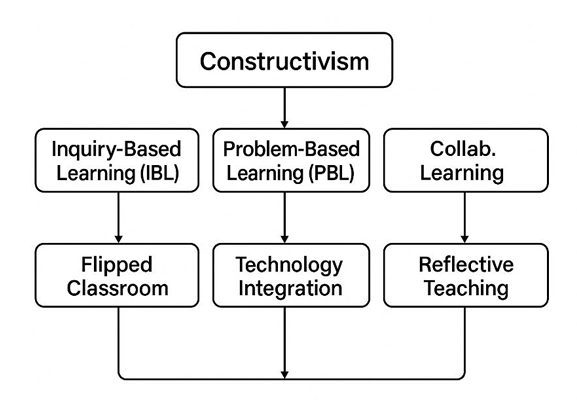Mapping and evaluating strategies for teaching mathematics in secondary education: A theoretical and reflective study
DOI:
https://doi.org/10.30862/eduversia.v1i1.887Keywords:
Constructivist learning, mathematics education, reflective teaching, secondary education, teaching strategiesAbstract
This study aims to map and evaluate various teaching strategies used in secondary mathematics education through a theoretical and reflective approach. With a focus on literature published between 2019 and 2024, this research synthesizes findings from reputable academic sources to identify dominant instructional methods and assess their effectiveness based on pedagogical theory and contextual application. The results highlight five major strategies: Inquiry-Based Learning (IBL), Problem-Based Learning (PBL), collaborative learning, flipped classroom, and technology-integrated instruction. These approaches are grounded in constructivist learning theory and foster active student engagement, critical thinking, and a deeper conceptual understanding. Through thematic synthesis and reflective analysis, the study finds that while these strategies offer considerable benefits, their implementation is highly context-dependent. Factors such as teacher pedagogical competence, institutional support, digital infrastructure, and classroom culture significantly influence their success. Moreover, integrating reflective teaching practices with the Technological Pedagogical Content Knowledge (TPACK) framework is crucial for enhancing strategy adaptability and relevance. The findings emphasize that no single teaching strategy is universally effective. Instead, effective mathematics instruction requires thoughtful adaptation and a combination of methods tailored to student needs and learning environments. This study contributes a conceptual foundation for teachers, education policymakers, and curriculum developers to promote equitable and evidence-based mathematics education in secondary schools.
References
Agyei, D. D., & Voogt, J. (2012). Developing technological pedagogical content knowledge in pre-service mathematics teachers through collaborative design. Australasian journal of educational technology, 28(4). https://doi.org/10.14742/ajet.827
Aria, M., & Cuccurullo, C. (2017). bibliometrix: An R-tool for comprehensive science mapping analysis. Journal of Informetrics, 11(4), 959–975. https://doi.org/10.1016/j.joi.2017.08.007
Darling-Hammond, L., Flook, L., Cook-Harvey, C. M., Barron, B., & Osher, D. (2020). Implications for educational practice of the science of learning and development. Applied Developmental Science, 24(2), 97–140. https://doi.org/10.1080/10888691.2018.1537791
Frolova, E. V., Ryabova, T. M., & Rogach, O. V. (2019). Digital Technologies in Education: Problems and Prospects for" Moscow Electronic School" Project Implementation. European Journal of Contemporary Education, 8(4), 779-789. https://doi.org/10.13187/ejced.2019.4.779
Goos, M., Stillman, G., Herbert, S., & Geiger, V. (2020). Teaching secondary school mathematics: Research and practice for the 21st century. Routledge. https://doi.org/10.4324/9781003117810
Hoidn, S., & Reusser, K. (2020). Foundations of student-centered learning and teaching. In The Routledge international handbook of student-centered learning and teaching in higher education (pp. 17-46). Routledge. https://doi.org/10.4324/9780429259371-3
Keengwe, J., Onchwari, G., & Onchwari, J. (2009). Technology and student learning: Towards a learner-centered teaching model. AACE Review (Formerly AACE Journal), 17(1), 11-22.
Niess, M. L., Ronau, R. N., Shafer, K. G., Driskell, S. O., Harper, S. R., Johnston, C., ... & Kersaint, G. (2009). Mathematics teacher TPACK standards and development model. Contemporary issues in technology and teacher education, 9(1), 4-24.
OECD. (2020). PISA 2018 results (Volume III): What school life means for students’ lives. OECD Publishing. https://doi.org/10.1787/acd78851-en
Slade, M. L., Burnham, T. J., Catalana, S. M., & Waters, T. (2019). The Impact of Reflective Practice on Teacher Candidates' Learning. International Journal for the Scholarship of Teaching and Learning, 13(2), 15. https://doi.org/10.20429/ijsotl.2019.130215
Suparman, A. R., Murtihapsari, M., & Purwati, P. (2025). Empowering teachers in item response theory analysis using R Studio in Manokwari. Abdimas: Jurnal Pengabdian Masyarakat Universitas Merdeka Malang, 10(1). https://doi.org/10.26905/abdimas.v10i1.14258
Suparman, A. R., Murtihapsari, M., Astari, B. F., Ramlah, R., & Faisal, F. (2025). Development of Augmented Reality Media Based on Assembler Edu on Molecular Geometry. Quantum: Jurnal Inovasi Pendidikan Sains, 16(1). https://doi.org/10.20527/quantum.v16i1.22025

Downloads
Published
How to Cite
Issue
Section
License
Copyright (c) 2025 Anan Dita, Yusra, Nurhasanah

This work is licensed under a Creative Commons Attribution-ShareAlike 4.0 International License.








